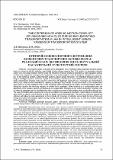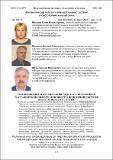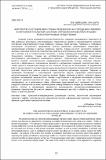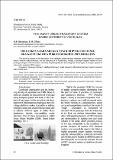| dc.contributor.author | Shviatsova, O. V. | |
| dc.contributor.author | Shuts, V. M. | |
| dc.coverage.spatial | Kyiv | ru_RU |
| dc.date.accessioned | 2021-05-20T13:19:56Z | |
| dc.date.available | 2021-05-20T13:19:56Z | |
| dc.date.issued | 2020 | |
| dc.identifier.citation | Shviatsova, O. V. The criterion of arising motion conflict of unmanned vehicles during implementing transportation plan in intelligent urban passenger transportation system / O. V. Shviatsova, V. M. Shuts // Artificial Intelligence. – 2020. – № 3, iss. 89. – P. 79–84. | ru_RU |
| dc.identifier.uri | https://rep.bstu.by/handle/data/17308 | |
| dc.description | О.В. Швецова, В.М. Шуть. КРИТЕРІЙ БЕЗКОНФЛІКТНОГО ДОТРИМАННЯ
БЕЗПІЛОТНИХ ТРАНСПОРТНИХ ЗАСОБІВ ПІД ЧАС
РЕАЛІЗАЦІЇ ПЛАНУ ПЕРЕВЕЗЕННЯ В ІНТЕЛЕКТУАЛЬНІЙ
ПАСАЖИРСЬКІЙ ТРАНСПОРТНІЙ СИСТЕМІ | ru_RU |
| dc.description.abstract | The proposed article is devoted to the description of an intelligent urban passenger transport system
based on unmanned electric vehicles, sequentially moving along a separate line. This system is a passenger transport
system of a new urban mobility, formed under the influence of social conditions generated by high population density
in cities, that suppose the development of pedestrian zones and ecological modes of transport, "transport as a service",
etc. In this historical context, public transport systems acquire special relevance. The described transport system belongs
to intelligent systems, since it is capable of functioning in autonomous mode without human intervention, adaptively
responding to changes in the dynamics of the flow of passengers during the day. Passengers are transported by
electric cars, which can be combined into cassettes according to the principle of road trains based on the transportation
plan drawn up by the intelligent center of the transport system according to the matrix of correspondences, filled in
taking into account the incoming requests for service from passengers. When drawing up a transportation plan, the
algorithms of the transport system give preference to transportation according to the "source-destination" principle, that
is, when the passenger goes to the destination with a minimum number of intermediate stops, and ideally without them.
The paper formulates also a criterion of arising of a conflict in the movement of vehicles, which allows to identify situations
when an electric vehicle driving in front can detain vehicles following after. The work has relevance because the
criterion will allow to make adjustments in the schedule of movement of vehicles and exclude the loss of time and
energy that carries the transport system during braking and acceleration of electric cars, as well as to reduce waiting
time and travel of passengers. | ru_RU |
| dc.language.iso | en | ru_RU |
| dc.publisher | Institute of Artificial Intelligence Problems, Ministry of Education and Science of Ukraine and National Academy of Sciences of Ukraine | ru_RU |
| dc.subject | intelligent passenger transport system | ru_RU |
| dc.subject | INFOBUS | ru_RU |
| dc.subject | transportation plan | ru_RU |
| dc.subject | correspondence matrix | ru_RU |
| dc.subject | cassette transportation | ru_RU |
| dc.subject | information and transport system | ru_RU |
| dc.subject | conflict-free movement | ru_RU |
| dc.subject | інтелектуальна пасажирська транспортна система | ru_RU |
| dc.subject | ІНФОБУС | ru_RU |
| dc.subject | план перевезення | ru_RU |
| dc.subject | матриця кореспонденцій касетні перевезення | ru_RU |
| dc.subject | інформаційно-транспортна система | ru_RU |
| dc.subject | безконфліктний рух | ru_RU |
| dc.title | The criterion of arising motion conflict of unmanned vehicles during implementing transportation plan in intelligent urban passenger transportation system | ru_RU |
| dc.type | Статья (Article) | ru_RU |
| dc.identifier.udc | 656.13 | ru_RU |
| dc.abstract.alternative | Запропонована стаття присвячена опису інтелектуальної міської пасажирської транспортної
системи на базі безпілотних електрокарів, які послідовно здійснюють рух по відокремленій лінії. Описана система є пасажирською транспортною системою нової міської мобільності, що формується під впливом соціальних умов, породжених високою щільністю населення в містах, яка буде припускати розвиток пішохідних зон і екологічних видів транспорту, наприклад, «транспорт як послуга» і т. д. В цьому історичному контексті набувають особливої актуальності громадські транспортні системи. Описана транспортна система відноситься до інтелектуальних систем, так як здатна функціонувати в автономному режимі, без участі людини, адаптивно реагуючи на зміну динаміки потоку пасажирів протягом доби. Перевезення пасажирів здійснюється електрокарами, які можуть об'єднуватися в касети за принципом автопоїздів на основі складеного інтелектуальним центром транспортної системи плану перевезень, по матриці кореспонденцій, що заповнюється з урахуванням заявок на обслуговування від пасажирів. При складанні плану перевезень алгоритмами транспортної системи віддається перевага перевезенням за принципом «джерело-призначення», тобто коли пасажир прямує до пункту призначення з мінімальною кількістю проміжних зупинок (а в ідеалі ‒ без них). Також формулюється критерій
створення конфлікту руху транспортних засобів, що дозволяє виявити ситуації, коли електромобіль, що їде попереду, може затримати транспортні засоби, які йдуть за ним. Робота має актуальність, так як цей критерій дозволить вносити коригування в графік руху транспортних засобів і виключати втрати часу і енергії, які несе
транспортна система при гальмуванні і розгоні електрокарів, а також знизити час очікування і поїздки
пасажирів. | ru_RU |
| dc.identifier.doi | https://doi.org/10.15407/jai2020.03.079 | |



